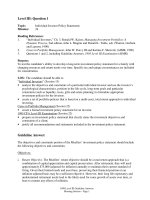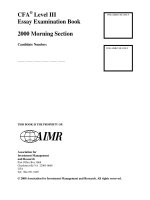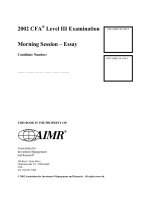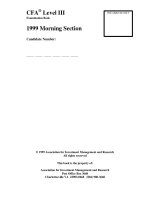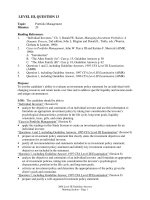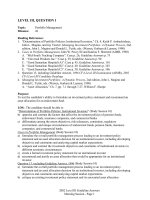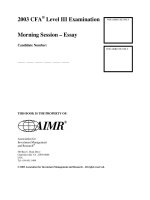L3 mock sample exam CFA level III guideline answers 2013
Bạn đang xem bản rút gọn của tài liệu. Xem và tải ngay bản đầy đủ của tài liệu tại đây (232.88 KB, 38 trang )
LEVEL III
Question:
Topic:
Minutes:
1
Individual PM
20
Reading References:
10.
“Managing Individual Investor Portfolios,” Ch. 2, Managing Investment Portfolios: A
Dynamic Process, 3rd edition, James W. Bronson, Matthew H. Scanlan, and Jan R.
Squires (CFA Institute, 2007).
LOS: 2013-III-4-10-j-m
10.
“Managing Individual Investor Portfolios”
The candidate should be able to:
a) discuss how source of wealth, measure of wealth, and stage of life affect an
individual investor’s risk tolerance;
b) explain the role of situational and psychological profiling in understanding an
individual investor;
c) compare the traditional finance and behavioral finance models of investor decision
making;
d) explain the influence of investor psychology on risk tolerance and investment
choices;
e) explain the use of a personality typing questionnaire for identifying an investor’s
personality type;
f)
compare risk attitudes and decision-making styles among distinct investor
personality types, including cautious, methodical, spontaneous, and individualistic
investors;
g) explain the potential benefits, for both clients and investment advisers, of having a
formal investment policy statement;
h) explain the process involved in creating an investment policy statement;
i)
distinguish between required return and desired return and explain the impact these
have on the individual investor’s investment policy;
j)
explain how to set risk and return objectives for individual investor portfolios
and discuss the impact that ability and willingness to take risk have on risk
tolerance;
k) discuss each of the major constraint categories included in an individual
investor’s investment policy statement;
l)
formulate and justify an investment policy statement for an individual
investor;
m) determine the strategic asset allocation that is most appropriate for an
individual investor’s specific investment objectives and constraints;
n) compare Monte Carlo and traditional deterministic approaches to retirement
planning and explain the advantages of a Monte Carlo approach.
© 2013 CFA Institute. All rights reserved.
2013 Level III Guideline Answers
Morning Session - Page 1 of 38
LEVEL III
Question:
Topic:
Minutes:
1
Individual PM
20
Guideline Answer:
Part A
Required After-tax Rate of Return
Calculation
Cash Need Next Year
Total expenses last year
x (1 + Inflation rate)
Total expenses next year
300,000
1.025
307,500
Less after-tax retirement
income [125,000 x (1 – 0.30)]
87,500
Net cash need in coming year
220,000
Investable Assets
Net from Sale of Business
Gross proceeds from sale
Tax rate due on sale
Net from sale of business
Current Investment Portfolio
Total Investable Assets
10,000,000
15%
8,500,000
2,500,000
11,000,000
Required After-tax Rate of Return
Cash Need
Investable Assets
Real Required After-tax Rate
of Return
220,000
11,000,000
2.00%
Nominal Required After-tax Rate of Return (2.0% + Inflation of 2.5%) = 4.50%
Or, geometric return of 4.55% (1.02 x 1.025 – 1)
© 2013 CFA Institute. All rights reserved.
2013 Level III Guideline Answers
Morning Session - Page 2 of 38
LEVEL III
Question:
Topic:
Minutes:
1
Individual PM
20
ALTERNATE ANSWER
Remove the USD 250,000 cash reserve from the investable asset base, reducing the investable
asset base to USD 10,750,000. This results in:
Real Required After-tax Rate of Return (220,000 / 10,750,000) = 2.05%
Nominal Required After-tax Rate of Return (2.05% + Inflation of 2.5%) = 4.55%
Or, geometric return of 4.60% (1.0205 x 1.025 – 1)
Part B
Factors that indicate the Voorts’ ability to assume risk is above average:
•
•
•
•
•
They are relatively young and have a long time horizon, so they are likely to have time to
recover from any unanticipated adverse financial event.
They have a substantial asset base relative to their spending needs.
The couple has relatively stable spending habits and does not expect any significant cash
outflows in the future.
They own a home and have no debt, so the home could be sold or borrowed against if
cash is needed.
They are relatively young and have the ability to seek employment if necessary.
Part C
The liquidity requirement for the Voorts in the coming year has two components: net cash needs
for living expenses and an emergency reserve. Their annual expenses are estimated to increase
by inflation of 2.5% (USD 300,000 last year x 1.025 = USD 307,500). Retirement income is
reduced by taxes of 30% (USD 125,000 x (1 – 0.30) = USD 87,500). The net cash need for
expenses is thus USD 220,000. In addition, the Voorts want to establish and maintain a cash
reserve of USD 250,000. Therefore, the Voorts’ total liquidity requirement for the next year is
USD 470,000 (USD 220,000 + USD 250,000).
Part D
The most appropriate portfolio for the Voorts must meet the following requirements:
1. Real after-tax return of 3.5% or more ((pre-tax return × (1 – tax rate)) – inflation rate)
2. Shortfall risk of no lower than –10% in any one year (equal to nominal pre-tax expected
return minus two times standard deviation)
© 2013 CFA Institute. All rights reserved.
2013 Level III Guideline Answers
Morning Session - Page 3 of 38
LEVEL III
Question:
Topic:
Minutes:
1
Individual PM
20
The following analysis shows whether each portfolio meets (pass/fail) the specified return and
risk requirements:
Portfolio X
Return Objective:
Real after-tax return: 9.3% × (1 – 30%) – 2.5% = 4.0% > 3.5%; pass
Shortfall risk constraint:
Shortfall risk: 9.3% – (2 × 11.0%) = –12.7% < –10.0%; fail
Portfolio Y
Return Objective:
Real after-tax return: 8.4% × (1 – 30%) – 2.5% = 3.4% < 3.5%; fail
Shortfall risk constraint:
Shortfall risk: 8.4% – (2 × 8.7%) = –9.0% < –10.0%; pass
Portfolio Z
Return Objective:
Real after-tax return: 8.8% × (1 – 30%) – 2.5 = 3.7 > 3.5; pass
Shortfall risk constraint:
Shortfall risk: 8.8% – (2 × 9.3%) = –9.8% > –10.0%; pass
Porfolio X does not meet the shortfall risk constraint and Portfolio Y does not meet the return
objective. Portfolio Z is the only one of the three proposed portfolios that meets both the return
objective and the shortfall risk constraint.
© 2013 CFA Institute. All rights reserved.
2013 Level III Guideline Answers
Morning Session - Page 4 of 38
LEVEL III
Question:
Topic:
Minutes:
2
Individual PM
15
Reading References:
12.
“Estate Planning in a Global Context,” Stephen M. Horan, CFA, and Thomas R.
Robinson, CFA (CFA Institute, 2009).
LOS: 2013-III-4-12-a, b, d-g
12.
“Estate Planning in a Global Context”
The candidate should be able to
a) discuss the purpose of estate planning and explain the basic concepts of domestic
estate planning, including estates, wills and probate;
b) explain the two principal forms of wealth transfer taxes and discuss the impact
of important non-tax issues, such as legal system, forced heirship, and marital
property regime;
c) determine a family’s core capital and excess capital, based on mortality probabilities
and Monte Carlo analysis;
d) evaluate the relative after-tax value of lifetime gifts and testamentary bequests;
e) explain the estate planning benefit of making lifetime gifts when gift taxes are
paid by the donor, rather than the recipient;
f) evaluate the after-tax benefits of basic estate planning strategies, including
generation skipping, spousal exemptions, valuation discounts, and charitable
gifts;
g) explain the basic structure of a trust and discuss the differences between
revocable and irrevocable trusts;
h) explain how life insurance can be a tax-efficient means of wealth transfer;
i) discuss the two principal systems (source jurisdiction and residence jurisdiction) for
establishing a country’s tax jurisdiction;
j) discuss the possible income and estate tax consequences of foreign situated assets and
foreign-sourced income;
k) evaluate a client’s tax liability under each of three basic methods (credit, exemption,
and deduction) that a country may use to provide relief from double taxation;
l) discuss the impact of increasing international transparency and information exchange
among tax authorities on international estate planning.
© 2013 CFA Institute. All rights reserved.
2013 Level III Guideline Answers
Morning Session - Page 5 of 38
LEVEL III
Question:
Topic:
Minutes:
2
Individual PM
15
Guideline Answer:
Part A
Puente’s total estate is USD 26 million.
His current wife is entitled to receive either:
• a minimum of 25 percent of the total estate under forced heirship:
USD 26 million x 0.25 = USD 6.5 million; or
• 50 percent of the increase in the value of the total estate during his current marriage
under community property:
(USD 26 million – USD 12 million) x 0.50 = USD 7.0 million
Therefore, the minimum amount that Puente’s current wife would receive, before estate taxes are
considered, if Puente were to die today, is the greater of her share under forced heirship or
community property; that is, USD 7.0 million.
Part B
A trust is an arrangement created by a settlor or grantor (in this case, Puente), who transfers
assets to a trustee. The trustee holds and manages the assets for the benefit of the beneficiaries
(Puente’s current wife and his four children - three sons from his current marriage and one
daughter from his previous marriage).
A trust would provide Puente the following benefits:
• Transfer of assets to his wife and children without the potential publicity associated
with probate. Puente has expressed a need for privacy.
• Protection of the assets within the trust from claims against him or his wife and
children, both now and in the future. Puente wants to secure their financial future and
worries about claims from outside of the family.
• Avoids disputes within the family (among his wife and four children).
• Responsible stewardship of assets while his children are minors, and afterwards if
they are unable to manage the assets themselves.
© 2013 CFA Institute. All rights reserved.
2013 Level III Guideline Answers
Morning Session - Page 6 of 38
LEVEL III
Question:
Topic:
Minutes:
2
Individual PM
15
Part C
Two reasons why tax considerations favor Puente making a current gift to his daughter rather
than transferring wealth to her through a bequest upon his death:
•
•
Because his daughter’s income tax rate is lower than Puente’s and their pre-tax
returns are assumed to be the same, the future after-tax value of any gifted amount
will be greater than if this amount stayed in Puente’s estate.
Because gift taxes are paid from Puente’s estate, the size of his taxable estate is
reduced. Because his daughter’s estate will not be taxed, this lowers the ultimate
estate tax that will be paid. The present value of this tax benefit is equal to the gift
tax rate, multiplied by the estate tax rate, multiplied by the size of the gift.
Part D
Generation-skipping is a strategy for reducing taxes by transferring assets directly to the third
generation (grandchild) from the first generation (Puente).
Transferring assets to the second generation (daughter) would incur transfer taxes. A second
layer of taxes would be assessed when assets are transferred from his daughter to his grandchild.
The generation-skipping strategy through a direct gift to his grandchild avoids this double layer
of taxation, thereby reducing overall taxes.
© 2013 CFA Institute. All rights reserved.
2013 Level III Guideline Answers
Morning Session - Page 7 of 38
LEVEL III
Question:
Topic:
Minutes:
3
PM - Behavioral
16
Reading References:
7.
“The Behavioral Finance Perspective,” Michael M. Pompian, CFA (CFA Institute, 2011)
9.
“Behavioral Finance and Investment Processes,” Michael M. Pompian, CFA, Colin
McLean, and Alistair Bryrne, CFA (CFA Institute, 2011)
LOS: 2013-III-3-7-a, d
7.
“The Behavioral Finance Perspective”
The candidate should be able to:
a. contrast traditional and behavioral finance perspectives on investor decision making;
b. contrast expected utility and prospect theories of investment decision making;
c. discuss the effects of cognitive and knowledge capacity limitations on investment decision
making;
d. compare traditional and behavioral finance perspectives on portfolio construction and
the behavior of capital markets.
LOS: 2013-III-3-9-c, d
9.
“Behavioral Finance and Investment Processes”
The candidate should be able to:
a. explain the uses and limitations of classifying investors into various types;
b. discuss how behavioral factors affect adviser-client interactions;
c. discuss how behavioral factors influence portfolio construction;
d. explain how behavioral finance can be applied to the process of portfolio
construction;
e. discuss how behavioral factors affect analyst forecasts and recommend remedial
actions for analyst biases;
f. discuss how behavioral factors affect investment committee decision making and
recommend techniques for mitigating their effects;
g. describe how behavioral biases of investors can lead to market anomalies and
observed market characteristics.
© 2013 CFA Institute. All rights reserved.
2013 Level III Guideline Answers
Morning Session - Page 8 of 38
LEVEL III
Question:
Topic:
Minutes:
3
PM - Behavioral
16
Guideline Answer:
Part A
Siosan has a risk-seeking (convex) utility function for gains and a risk-averse (concave) utility
function for losses. This is consistent with a Friedman-Savage utility function characterized by
an inflection point where the function turns from concave to convex. This type of function
explains why people may take low-probability, high-payoff risks (e.g., out-of-the-money
options) while at the same time insuring against low-probability, low-payoff risks (e.g.,
earthquake insurance). The concave portion of the utility function explains purchasing lowpayoff insurance against low-probability losses, while the convex portion of the function
explains risk taking with options.
Traditional finance theory assumes risk aversion (concave utility function) at all levels of wealth,
which would lead to rejection of all gambles having a non-positive expected return.
© 2013 CFA Institute. All rights reserved.
2013 Level III Guideline Answers
Morning Session - Page 9 of 38
LEVEL III
Question:
Topic:
Minutes:
3
PM - Behavioral
16
Part B
Template for Question 3-B
Behavioral
bias
i. self-control
ii. mental
accounting
Discuss how Siosan’s behavior
reflects each bias.
Siosan exhibits a self-control bias by
spending all of her current salary
income and half her bonus income on
current consumption, pursuing shortterm satisfaction to the detriment of
long-term financial security.
Explain how a rational economic
individual in traditional finance
would behave differently with
respect to each bias.
A rational economic individual uses
self-control to pursue long-term goals
rather than short-term satisfaction,
achieving an optimal consumption plan
that maximizes expected utility over his
or her lifetime.
Siosan is engaging in mental
A rational economic individual:
accounting by classifying her sources
• does not use mental accounts,
of wealth into three accounts: current
but treats money and wealth as
income, currently-owned assets, and
fungible;
the present value of future income.
• optimizes spending and
Her consumption and savings
investment decisions regardless
decisions are based on the source of
of the source of wealth; and
her wealth. She spends her salary
• does not segregate investments
and one-half of her bonus income,
based on their purposes, but
does not spend currently-owned
views all assets in a portfolio
assets (retirement accounts), and does
context, considering correlations
not consume based on expectations of
between assets to construct an
future income (her only debt is a
optimal portfolio.
small mortgage on her home despite
expectations of high future earnings).
Siosan is also engaging in mental
accounting by considering her
investments separately based on their
purposes. Her retirement account is
for long-term financial security and
her options trading account is for
short-term gains when they are
exercised in-the-money.
© 2013 CFA Institute. All rights reserved.
2013 Level III Guideline Answers
Morning Session - Page 10 of 38
LEVEL III
Question:
Topic:
Minutes:
3
PM - Behavioral
16
Part C
Murray is correct that Siosan’s retirement portfolio allocation is consistent with Behavioral
Portfolio Theory (BPT) and not consistent with a mean-variance framework (MVF). A BPT
investor maximizes expected wealth subject to a safety constraint. As a result, the optimal
portfolio of a BPT investor is a combination of bonds or riskless assets and highly speculative
assets. Siosan’s portfolio is consistent with BPT and is constructed in layers, which may be the
result of mental accounting.
An MVF investor constructs portfolios in a comprehensive manner. MVF portfolios are meanvariance efficient and take into account the investor’s risk tolerance, investment objectives and
constraints, and circumstances. Siosan’s portfolio is not mean-variance efficient because it
appears that no consideration has been given to the covariance of returns between different
assets, and there is no evidence that Siosan has considered her risk tolerance, investment
objectives and constraints, or circumstances.
© 2013 CFA Institute. All rights reserved.
2013 Level III Guideline Answers
Morning Session - Page 11 of 38
LEVEL III
Question:
Topic:
Minutes:
4
Equity
17
Reading References:
27.
“Equity Portfolio Management,” Ch. 7, Managing Investment Portfolios: A Dynamic
Process, 3rd edition, Gary Gastineau, Andrew R. Olma, and Robert G. Zielinski (CFA
Institute, 2007).
29.
“International Equity Benchmarks,” Ch. 10, Benchmarks and Investment Management,
Laurence B. Siegel (The Research Foundation of AIMR, 2003).
LOS: 2013-III-11-27-j
27.
“Equity Portfolio Management”
The candidate should be able to:
a) discuss the role of equities in the overall portfolio;
b) discuss the rationales for passive, active, and semiactive (enhanced index) equity
investment approaches and distinguish among those approaches with respect to
expected active return and tracking risk;
c) recommend an equity investment approach when given an investor’s investment
policy statement and beliefs concerning market efficiency;
d) distinguish among the predominant weighting schemes used in the construction of
major equity share indices and evaluate the biases of each;
e) compare alternative methods for establishing passive exposure to an equity market,
including indexed separate or pooled accounts, index mutual funds, exchangetraded funds, equity index futures, and equity total return swaps;
f) compare full replication, stratified sampling, and optimization as approaches to
constructing an indexed portfolio and recommend an approach when given a
description of the investment vehicle and the index to be tracked;
g) explain and justify the use of equity investment–style classifications and discuss the
difficulties in applying style definitions consistently;
h) explain the rationales and primary concerns of value investors and growth investors
and discuss the key risks of each investment style;
i)
compare techniques for identifying investment styles and characterize the style of
an investor when given a description of the investor’s security selection method,
details on the investor’s security holdings, or the results of a returns-based style
analysis;
j)
compare the methodologies used to construct equity style indices;
k) interpret the results of an equity style box analysis and discuss the consequences of
style drift;
l)
distinguish between positive and negative screens involving socially responsible
investing criteria and discuss their potential effects on a portfolio’s style
characteristics;
m) compare long–short and long-only investment strategies, including their risks and
potential alphas, and explain why greater pricing inefficiency may exist on the short
side of the market;
n) explain how a market-neutral portfolio can be “equitized” to gain equity market
exposure and compare equitized market-neutral and short-extension portfolios;
© 2013 CFA Institute. All rights reserved.
2013 Level III Guideline Answers
Morning Session - Page 12 of 38
LEVEL III
Question:
Topic:
Minutes:
o)
p)
q)
r)
s)
t)
u)
v)
4
Equity
17
compare the sell disciplines of active investors;
contrast derivatives-based and stock-based enhanced indexing strategies and justify
enhanced indexing on the basis of risk control and the information ratio;
recommend and justify, in a risk–return framework, the optimal portfolio
allocations to a group of investment managers;
explain the core-satellite approach to portfolio construction and discuss the
advantages and disadvantages of adding a completeness fund to control overall risk
exposures;
distinguish among the components of total active return (“true” active return and
“misfit” active return) and their associated risk measures and explain their relevance
for evaluating a portfolio of managers;
explain alpha and beta separation as an approach to active management and
demonstrate the use of portable alpha;
describe the process of identifying, selecting, and contracting with equity managers;
contrast the top-down and bottom-up approaches to equity research.
LOS: 2013-III-12-29-b,c
29.
“International Equity Benchmarks”
The candidate should be able to:
a) discuss the need for float adjustment in the construction of international equity
benchmarks;
b) discuss trade-offs involved in constructing international indices, including (1)
breadth versus investability, (2) liquidity and crossing opportunities versus
index reconstitution effects, (3) precise float adjustment versus transactions
costs from rebalancing, and (4) objectivity and transparency versus judgment;
c) discuss the effect that a country’s classification as either a developed or an
emerging market can have on market indices and on investment in the
country’s capital markets.
© 2013 CFA Institute. All rights reserved.
2013 Level III Guideline Answers
Morning Session - Page 13 of 38
LEVEL III
Question:
Topic:
Minutes:
4
Equity
17
Guideline Answer:
Part A
Template for Question 4-A
Determine if each of
Kimi Capital’s index
construction criteria in
Exhibit 1 will most
Index
likely result in lower,
construction
no difference in, or
criterion
higher transaction
costs relative to each of
the criteria of its main
competitor.
(circle one)
lower
Index breadth as
percent of total
market
capitalization
Justify each response with one reason.
Greater index breadth would mean including
less-liquid equities in the index, which would
increase transaction costs.
no difference
higher
lower
Float adjustment
no difference
Use of float bands reduces the number of
rebalancing transactions compared with singlepoint float adjustments, and thus lowers
transaction costs.
higher
lower
Selection of index
constituents
no difference
Use of objective, clearly stated rules enables
index funds to predict which firms will be in the
benchmark, and as a result to trade more
efficiently in anticipation of changes in
benchmark constituents. This lowers
transaction costs.
higher
© 2013 CFA Institute. All rights reserved.
2013 Level III Guideline Answers
Morning Session - Page 14 of 38
LEVEL III
Question:
Topic:
Minutes:
4
Equity
17
Part B
Badaar’s Equity Market
Inclusion in the larger Developed Market Index should provide benefits to Badaar’s national
equity market. All else equal, it would likely promote capital inflows into Badaar’s capital
markets because more assets are committed internationally to developed market investments than
emerging market investments. As a result, it is generally preferable for a country to have a small
weighting in a developed market index rather than a large weighting in an emerging market
index.
Index Funds Tracking the Emerging Market Index
While Badaar is a good fit for the Emerging Market Index in some ways, its total market
capitalization is large compared to that of the entire Emerging Market Index. It would become
35% of the total Emerging Market Index, considerably changing the overall index and requiring
significant turnover (resulting in higher transaction costs) upon its inclusion for index funds
tracking the Emerging Market Index.
Part C
Aspects of Kimi Capital’s Style Index Construction Likely to Increase Turnover:
• No overlap between categories – stocks are assigned to one or the other category with no
overlap or splitting between categories. This tends to create more reassignments of a
stock from one category to the other, which increases the number of rebalancing
transactions.
• No buffering – buffering would help avoid frequent changes of classification on stocks
that have some characteristics of each style.
• Exclusion of holding companies – because holding companies’ classifications are more
stable over time, excluding holding companies would result in higher turnover.
Note:
• The use of multiple variables to define each category is more likely to reduce turnover, as
styles defined by multiple characteristics should be more stable than those defined by a
single characteristic.
© 2013 CFA Institute. All rights reserved.
2013 Level III Guideline Answers
Morning Session - Page 15 of 38
LEVEL III
Question:
Topic:
Minutes:
5
Economics
20
Reading References:
19.
Equity Market Valuation,” Peter C. Stimes, CFA and Stephen E. Wilcox, CFA (CFA
Institute, 2010)
20.
“Dreaming With BRICs: The Path to 2050,” Dominic Wilson and Roopa Purushothaman,
Global Economics Paper No. 99 (Goldman Sachs, 2003).
LOS: 2013-III-7-19-a,f,g
19.
“Equity Market Valuation”
The candidate should be able to:
a) explain the terms of the Cobb-Douglas production function and demonstrate
how the function can be used to model growth in real output under the
assumption of constant returns to scale;
b) evaluate the relative importance of growth in total factor productivity, in capital
stock, and in labor input given relevant historical data;
c) demonstrate the use of the Cobb-Douglas production function in obtaining a
discounted dividend model estimate of the intrinsic value of an equity market;
d) critique the use of discounted dividend models and macroeconomic forecasts to
estimate the intrinsic value of an equity market;
e) contrast top-down and bottom-up approaches to forecasting the earnings per share
of an equity market index;
f)
discuss the strengths and limitations of relative valuation models;
g) judge whether an equity market is under-, fairly, or over-valued using a
relative equity valuation model.
LOS: 2013-III-7-20-c
20.
“Dreaming With BRICs: The Path to 2050”
Note: This reading is presented as an example of how economic analysis can serve as
the basis for building an emerging markets investment strategy; the inclusion of this
reading does not represent an endorsement of the authors’ specific conclusions.
The candidate should be able to:
a) compare the economic potential of emerging markets such as Brazil, Russia, India,
and China (BRICs) to that of developed markets, in terms of economic size and
growth, demographics and per capita income, growth in global spending, and trends
in real exchange rates;
b) explain why certain developing economies may have high returns on capital, rising
productivity, and appreciating currencies;
c) explain the importance of technological progress, employment growth, and
growth in capital stock in estimating the economic potential of an emerging
market;
d) discuss the conditions necessary for sustained economic growth, including the core
factors of macroeconomic stability, institutional efficiency, open trade, and worker
education;
© 2013 CFA Institute. All rights reserved.
2013 Level III Guideline Answers
Morning Session - Page 16 of 38
LEVEL III
Question:
Topic:
Minutes:
e)
5
Economics
20
evaluate the investment rationale for allocating part of a well-diversified portfolio to
emerging markets in countries with above average economic potential.
© 2013 CFA Institute. All rights reserved.
2013 Level III Guideline Answers
Morning Session - Page 17 of 38
LEVEL III
Question:
Topic:
Minutes:
5
Economics
20
Guideline Answers:
Part A
The basic form of the Cobb-Douglas production function is set forth as:
Y = AKαLβ
Where
Y = total real economic output
A = total factor productivity (TFP)
K = capital stock
α = output elasticity of capital (K)
L = labor input
β = output elasticity of labor (L)
Under the assumption of constant returns to scale, the output elasticity of labor = (1 – output
elasticity of capital) or β = (1 – α).
An approximation of the percentage change in real economic output (GDP) is:
∆Y ∆A
∆K
∆L
≈
+α
+ (1 − α )
Y
A
K
L
Or:
Estimated percentage change in real GDP = % growth in total factor productivity
+ (output elasticity of capital) x (% growth in capital stock)
+ (output elasticity of labor) x (% growth in labor input)
The estimated change in real GDP is 5.9%, calculated as:
∆Y ∆A
∆K
∆L
= 1.3% + [0.7 x 5.5%] + [0.3 x 2.5%] = 5.9%
≈
+α
+ (1 − α )
Y
A
K
L
© 2013 CFA Institute. All rights reserved.
2013 Level III Guideline Answers
Morning Session - Page 18 of 38
LEVEL III
Question:
Topic:
Minutes:
5
Economics
20
Part B
Template for Question 5-B
Policy
Determine whether
each proposed policy
will most likely
decrease, have no
effect on, or increase
the long-run CobbDouglas growth
projection for Westria.
(circle one)
Policy 1:
decrease
Offer incentives to limit
the average number of
children per family.
no effect
increase
Policy 2:
Increase the maximum
allowable annual
contribution to tax-free
retirement accounts.
decrease
no effect
increase
© 2013 CFA Institute. All rights reserved.
Justify each response with one reason.
Incentives to limit the average number of
children per family will most likely limit
population growth, and therefore reduce
the growth rate of the labor input (∆L/L) in
the long run. Reducing the growth rate of
the labor input, holding all else constant,
will decrease the long-run growth
projection.
Increasing the maximum allowable annual
contribution to tax-free retirement
accounts:
• will most likely increase the rate of
savings and investment, and
therefore increase the growth rate
of the capital stock (∆K/K).
Increasing the growth rate of capital
stock, holding all else constant, will
increase the long-run growth
projection.
• could increase the total factor
productivity (TFP) due to a) an
improvement in the level of
technology, or b) a reduction in
taxes. Increasing the growth rate of
TFP, holding all else constant, will
increase the long-run growth
projection.
2013 Level III Guideline Answers
Morning Session - Page 19 of 38
LEVEL III
Question:
Topic:
Minutes:
5
Economics
20
Part C
Template for Question 5-C
Determine whether
Westria’s stock
market (using the
broad equity index as
Model
a proxy) is
undervalued, fairly
valued, or overvalued
using each model.
(circle one)
undervalued
i. Fed model
fairly valued
overvalued
undervalued
ii. Yardeni
model
Justify each response with one reason.
The Fed model hypothesizes that, in equilibrium, the
yield on long-term government bonds should be equal
to the forward earnings yield on a broad equity index
(defined as forward operating earnings divided by
index level). Differences in these yields identify an
overpriced or underpriced equity market.
Based on the data in Exhibit 2, the forward earnings
yield = (35.00 x 1.07) / 800 = 4.68%. Therefore,
Westria’s stock market is overvalued because the
forward earnings yield is lower than the 10-year
government bond yield, i.e., 4.68% < 5.10%.
The Yardeni model is similar to the Fed model, but
addresses some of the criticisms of the Fed model.
The Yardeni model uses the yield on risky debt (thus
incorporating a risk premium) and a projected longterm earnings growth rate to calculate a justified
forward earnings yield. Differences between that
yield and the forward earnings yield on a broad equity
index identify an overpriced or underpriced equity
market.
fairly valued
overvalued
© 2013 CFA Institute. All rights reserved.
Based on the data in Exhibit 2, the forward earnings
yield = (35.00 x 1.07) / 800 = 4.68% and the Yardeni
justified forward earnings yield = [10-year A-rated
corporate bond yield – (Yardeni weighting factor x
Projected long-term earnings growth rate)] = [0.059 –
(0.2 x 0.07)] = 4.50%. Therefore, Westria’s stock
market is undervalued because the forward earnings
yield is higher than the Yardeni justified forward
earnings yield, i.e., 4.68% > 4.50%.
2013 Level III Guideline Answers
Morning Session - Page 20 of 38
LEVEL III
Question:
Topic:
Minutes:
5
Economics
20
Part D
i.
The Fed model uses only the yield on long-term government bonds to estimate equity
valuations. Consequently, substituting the yield on BB-rated corporate bonds for A-rated
corporate bonds would have no effect on the fair value estimate of Westria’s stock market
as implied by the Fed model.
ii.
One of the improvements of the Yardeni model over the Fed model is that it includes a
risk premium by using the yield on risky debt. Therefore, substituting the yield on BBrated corporate bonds for A-rated corporate bonds would further increase the Yardeni
justified earnings yield and thus reduce the fair value estimate, making the stock market
of Westria appear less undervalued, or possibly overvalued.
© 2013 CFA Institute. All rights reserved.
2013 Level III Guideline Answers
Morning Session - Page 21 of 38
LEVEL III
Question:
Topic:
Minutes:
6
Institutional PM
18
Reading References:
15.
“Managing Institutional Investor Portfolios,” Ch. 3, Managing Investment Portfolios: A
Dynamic Process, 3rd edition, R. Charles Tschampion, Laurence B. Siegel, Dean J.
Takahashi, and John L. Maginn (CFA Institute, 2007).
LOS: 2013-III-5-15-j, l
15.
“Managing Institutional Investor Portfolios”
The candidate should be able to:
a) contrast a defined-benefit plan to a defined-contribution plan, from the perspective
of the employee and employer and discuss the advantages and disadvantages of
each;
b) discuss investment objectives and constraints for defined-benefit plans;
c) evaluate pension fund risk tolerance when risk is considered from the perspective of
the (1) plan surplus, (2) sponsor financial status and profitability, (3) sponsor and
pension fund common risk exposures, (4) plan features, and (5) workforce
characteristics;
d) prepare an investment policy statement for a defined-benefit plan;
e) evaluate the risk management considerations in investing pension plan assets;
f)
prepare an investment policy statement for a defined-contribution plan;
g) discuss hybrid pension plans (e.g., cash balance plans) and employee stock
ownership plans;
h) distinguish among various types of foundations, with respect to their description,
purpose, source of funds, and annual spending requirements;
i)
compare the investment objectives and constraints of foundations, endowments,
insurance companies, and banks;
j)
prepare an investment policy statement for a foundation, an endowment, an
insurance company, and a bank;
k) contrast investment companies, commodity pools, and hedge funds to other types of
institutional investors;
l)
discuss the factors that determine investment policy for pension funds,
foundations, endowments, life and nonlife insurance companies, and banks;
m) compare the asset/liability management needs of pension funds, foundations,
endowments, insurance companies, and banks;
n) compare the investment objectives and constraints of institutional investors given
relevant data, such as descriptions of their financial circumstances and attitudes
toward risk.
© 2013 CFA Institute. All rights reserved.
2013 Level III Guideline Answers
Morning Session - Page 22 of 38
LEVEL III
Question:
Topic:
Minutes:
6
Institutional PM
18
Guideline Answer:
Part A
Factors that support Smith’s conclusion that the Pearce Foundation’s risk tolerance is above
average:
•
•
•
The Pearce Foundation has a perpetual time horizon, which allows it opportunities to
make up for losses sustained by the portfolio.
The Pearce Foundation expects to receive ongoing annual contributions.
The Pearce Foundation does not have a contractually-defined liability stream. Its 6%
annual spending requirement is not a contractual obligation.
Part B
The elements of the nominal return requirement from Year 2 onwards are:
•
•
•
A 6% annual spending requirement.
Cost of managing the fund is 0.40% per annum.
An inflation rate for the college of 3.5%.
Therefore:
Nominal return requirement = (1 + 0.06) x (1 + 0.004) x (1 + 0.035) – 1 = 10.15%
(multiplicative method)
OR
Nominal return requirement = 6.0% + 0.4% + 3.5% = 9.9% (additive method)
OR
Nominal return requirement = (1 + 0.06 + 0.035) x 1.004 – 1 = 9.94% (calculation method,
reflecting exact timing of cash flows)
Part C
At the beginning of Year 1, USD 3 million is withdrawn from the portfolio, leaving
USD 97 million to be invested.
The portfolio value at the end of Year 1 is USD 105,730,000 (USD 97,000,000 x 1.09).
In Year 2, the Pearce Foundation’s liquidity requirement equals:
• 6% spending requirement = USD 105,730,000 x 0.06 = USD 6,343,800
• Management fees = USD 105,730,000 x 0.004 = USD 422,920
• Less: USD 2,000,000 contribution received at the beginning of Year 2.
Total liquidity requirement in Year 2 is 6,343,800 + 422,920 – 2,000,000 = USD 4,766,720.
© 2013 CFA Institute. All rights reserved.
2013 Level III Guideline Answers
Morning Session - Page 23 of 38
LEVEL III
Question:
Topic:
Minutes:
6
Institutional PM
18
Part D
Template for Question 6-D
Determine the effect
(decrease, no change,
increase) of these
changed circumstances
IPS component
on the Foundation’s
return objective and
liquidity requirement.
(circle one)
decrease
Return objective
no change
Justify each response with one reason.
The Foundation still needs to preserve the
real value of its investment portfolio and
meet its spending requirement.
increase
decrease
Liquidity requirement
The Foundation will no longer receive
ongoing contributions from Pearce.
no change
increase
© 2013 CFA Institute. All rights reserved.
2013 Level III Guideline Answers
Morning Session - Page 24 of 38
LEVEL III
Question:
Topic:
Minutes:
7
Institutional PM
14
Reading References:
16.
“Linking Pension Liabilities to Assets,” Aaron Meder and Renato Staub (UBS Global
Asset Management, 2006).
17.
“Allocating Shareholder Capital to Pension Plans,” Robert C. Merton, Journal of Applied
Corporate Finance (Morgan Stanley, vol. 18, Winter 2006).
LOS: 2013-III-5-16-a
16.
“Linking Pension Liabilities to Assets”
The candidate should be able to:
a) contrast the assumptions concerning pension liability risk in asset-only and
liability-relative approaches to asset allocation;
b) discuss the fundamental and economic exposures of pension liabilities and identify
asset types that mimic these liability exposures;
c) compare pension portfolios built from a traditional asset-only perspective to
portfolios designed relative to liabilities and discuss why corporations may choose
not to implement fully the liability mimicking portfolio.
LOS: 2013-III-5-17-a-c
17.
“Allocating Shareholder Capital to Pension Plans”
The candidate should be able to:
a) compare funding shortfall and asset/liability mismatch as sources of risk faced
by pension plan sponsors;
b) explain how the weighted average cost of capital for a corporation can be
adjusted to incorporate pension risk and discuss the potential consequences of
not making this adjustment;
c) explain, in an expanded balance sheet framework, the effects of different
pension asset allocations on total asset betas, the equity capital needed to
maintain equity beta at a desired level, and the debt-to-equity ratio.
© 2013 CFA Institute. All rights reserved.
2013 Level III Guideline Answers
Morning Session - Page 25 of 38
